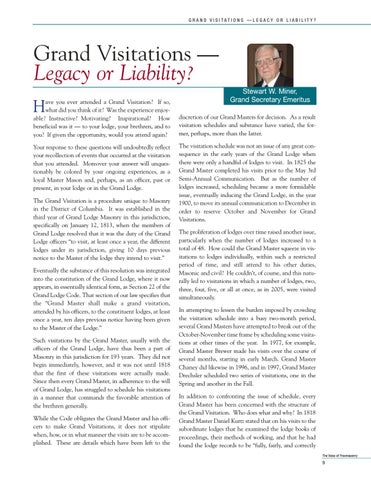GRAND VISITATIONS —LEGACY OR LIABILITY?
Grand Visitations — Legacy or Liability? ave you ever attended a Grand Visitation? If so, what did you think of it? Was the experience enjoyable? Instructive? Motivating? Inspirational? How beneficial was it — to your lodge, your brethren, and to you? If given the opportunity, would you attend again?
H
Your response to these questions will undoubtedly reflect your recollection of events that occurred at the visitation that you attended. Moreover your answer will unquestionably be colored by your ongoing experiences, as a loyal Master Mason and, perhaps, as an officer, past or present, in your lodge or in the Grand Lodge. The Grand Visitation is a procedure unique to Masonry in the District of Columbia. It was established in the third year of Grand Lodge Masonry in this jurisdiction, specifically on January 12, 1813, when the members of Grand Lodge resolved that it was the duty of the Grand Lodge officers “to visit, at least once a year, the different lodges under its jurisdiction, giving 10 days previous notice to the Master of the lodge they intend to visit.” Eventually the substance of this resolution was integrated into the constitution of the Grand Lodge, where it now appears, in essentially identical form, as Section 22 of the Grand Lodge Code. That section of our law specifies that the “Grand Master shall make a grand visitation, attended by his officers, to the constituent lodges, at least once a year, ten days previous notice having been given to the Master of the Lodge.” Such visitations by the Grand Master, usually with the officers of the Grand Lodge, have thus been a part of Masonry in this jurisdiction for 193 years. They did not begin immediately, however, and it was not until 1818 that the first of these visitations were actually made. Since then every Grand Master, in adherence to the will of Grand Lodge, has struggled to schedule his visitations in a manner that commands the favorable attention of the brethren generally. While the Code obligates the Grand Master and his officers to make Grand Visitations, it does not stipulate when, how, or in what manner the visits are to be accomplished. These are details which have been left to the
Stewart W. Miner, Grand Secretary Emeritus discretion of our Grand Masters for decision. As a result visitation schedules and substance have varied, the former, perhaps, more than the latter. The visitation schedule was not an issue of any great consequence in the early years of the Grand Lodge when there were only a handful of lodges to visit. In 1825 the Grand Master completed his visits prior to the May 3rd Semi-Annual Communication. But as the number of lodges increased, scheduling became a more formidable issue, eventually inducing the Grand Lodge, in the year 1900, to move its annual communication to December in order to reserve October and November for Grand Visitations. The proliferation of lodges over time raised another issue, particularly when the number of lodges increased to a total of 48. How could the Grand Master squeeze in visitations to lodges individually, within such a restricted period of time, and still attend to his other duties, Masonic and civil? He couldn’t, of course, and this naturally led to visitations in which a number of lodges, two, three, four, five, or all at once, as in 2005, were visited simultaneously. In attempting to lessen the burden imposed by crowding the visitation schedule into a busy two-month period, several Grand Masters have attempted to break out of the October-November time frame by scheduling some visitations at other times of the year. In 1977, for example, Grand Master Brewer made his visits over the course of several months, starting in early March. Grand Master Chaney did likewise in 1996, and in 1997, Grand Master Drechsler scheduled two series of visitations, one in the Spring and another in the Fall. In addition to confronting the issue of schedule, every Grand Master has been concerned with the structure of the Grand Visitation. Who does what and why? In 1818 Grand Master Daniel Kurtz stated that on his visits to the subordinate lodges that he examined the lodge books of proceedings, their methods of working, and that he had found the lodge records to be “fully, fairly, and correctly The Voice of Freemasonry
9







